At 10.30 on Saturday 13 May the Friends of the Wembdon Road Cemetery held their annual Spring walking tour. Rather than their usual historical themed talk, this walk focused on the Friends' hard work in the conservation of the cemetery.
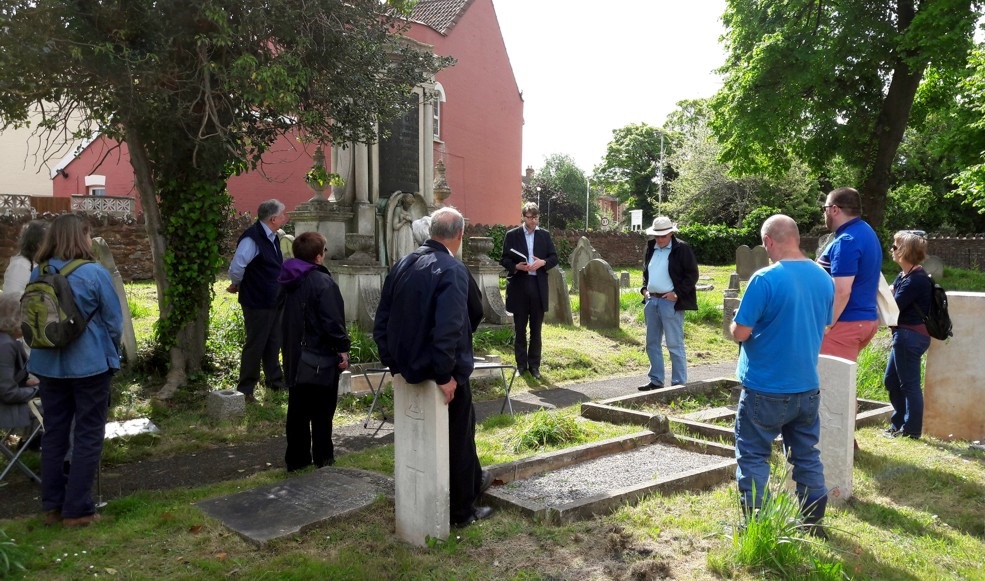
Everyone was welcomed to the cemetery. The tour began with the difficult question of what we should do with disused burial grounds, where there are no more interments and the number of direct living mourners dwindles each year. Some more callous individuals would argue that it doesn't matter, the place has served its purpose and time would come to reuse the land and build, the dead don't matter. The Friends take the contrary view, feeling that the dead should be left rest and they should be remembered. And, of course cemeteries are far more than just places to bury the dead, they are gardens of remembrance, not just of the dead buried there, but death in general, reminders of those we've lost and our own mortality, reminding us to lead a good life. They are also places of wildlife and parks of a different sort. While you might go to Victoria Park to enjoy a game or a run or a chat, you might come here for the quiet and for contemplation. But we have to ask ourselves, why this place is or isn't important and worth saving.
In 1851 the overcrowded and horrific state and overcrowding of St Mary's churchyard, and the smaller dissenter burial grounds in the town led to the creation of the Wembdon Road Cemetery. In 2010, the dilapidated and horrific state of the Wembdon Road Cemetery led to the formation of the Friends of the Wembdon Road Cemetery.
In 2008 the old Jam Factory was in the process of closing down and the site was earmarked for housing. Attention turned to the cemetery, which was in a horrific state of neglect. The neighbours over there had just seen off several waves of anti-social behaviour. Questions were asked of what to do? One quite possible proposal at the time was to sweep away all the memorials to leave a large green open space.
Modern Bridgwater has a disgraceful attitude towards our buried dead. Two Victorian burial grounds in Friarn Street have been completely destroyed, one under the old Armourery, which was a Unitarian burial ground, the other across the road where the old Sion chapel stood - that was dug up only a year ago. Another burial ground, for the Roman Catholics on the far side of town, in Gordon Terrace, was likewise utterly destroyed and built upon. The dead aren't allowed to rest in peace. It was good land, so why not redevelop? The dead don't contribute economically and with the growing housing crisis surely this was waste land, extravagant and superstitious. Again we utterly disagree with this, but again, it's difficult to argue with feelings about the treatment of the dead and a want to preserve history against cold, unfeeling and indifferent capitalism.
The threat to the buried dead here in the Wembdon Road, even if only by unintended increments, was real and pressing. No maintenance and brambles lead to restricted access and memorials are gradually removed with no one to know or care for them. Leave it ten years then eventually the land is sold off. It lays as waste for more years and housing developers move in. That's more or less exactly what happened with the Sion Chapel.
So in 2008 the Friends' current chairman came into the cemetery to record what was here in case it was lost. A number of meetings with like minded individuals were held and the Friends formed in 2010.
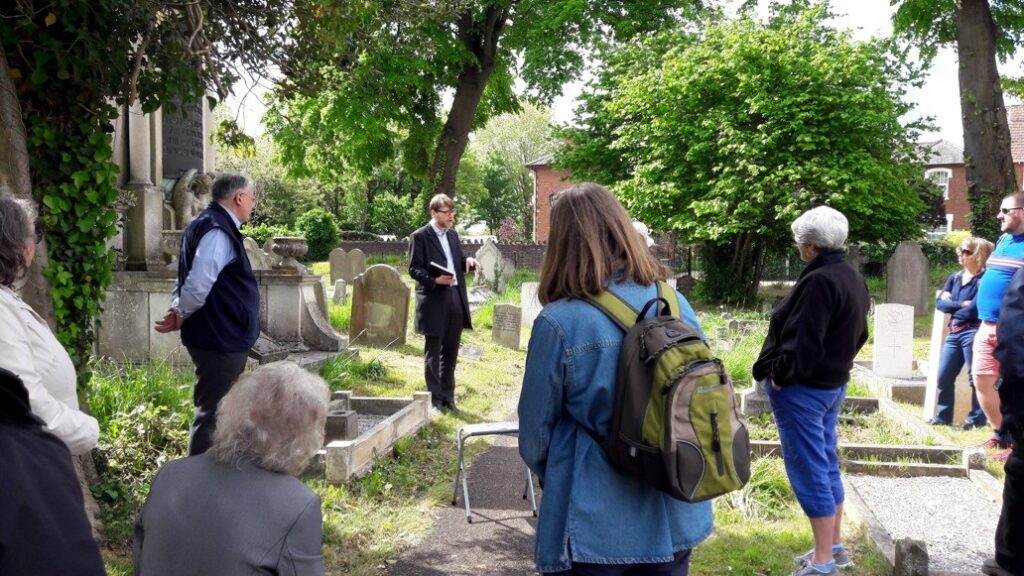
There were initially no protections on the cemetery. That's why one of the first things the Friends did was to have the memorial to Town Clerk James Cook listed. James Cook who was a great benefactor to many institutions in the town, was instrumental in the success of bringing a fresh water supply to the town with the Wembdon Reservoir and bought a great deal of prosperity to the town through careful management. His memorial though is very important. It was built in 1911 and this was a really unusually huge memorial for the time, most memorials in the 1910s being modest kerb type memorials. But this sort of monumental architecture was the forerunner of many of the war memorials which were built in Britain after the end of the First World War in 1918. As such this memorial was of national importance and has been listed Grade II.
Before moving on the modern black tombstone by the gates was noted. That was donated by the Cooperative Funeral Care of Bridgwater. The idea behind it being to acts as a signpost to the cemetery, giving the dates, like any memorial here, of when the cemetery was born and when it metaphorically died.
Also noted were the gates. The current gates date to the 1950s. The original wonderfully grand Victorian gates were removed in the Second World War for scrap. It is the Friends hope in the long run to replace those with something much grander, something with some architectural impact which will really catch the attention of anyone passing on the Wembdon Road. It's a real opportunity to have something this town can be rightly proud of and something more appropriate to the dignity of the dead buried here. The design might be put out for competition. Not necessarily a lifeless copy of what was there before, but the chance for something new and ambitious.

Moving on the group passed to the junction of the first path. Here the wonderful efforts to repair the Anglican Chapel Corner were explored, with almost twenty grand crosses being repaired and re-erected. In 2008 this part of the cemetery was an utter mess of disarticulated memorial pieces.
There were three main reasons the cemetery fell into such a state of disrepair. The first and most fundamental was that they ran out of space. The town had encroached all the way around the cemetery. With no more space, there was no room for new burials and no income to support a groundsman. The second reason is international, the economy of the country changed so people moved about much more. Many of the descendants of the people buried here don't live in the area anymore, so the family vaults and plots became untended. Finally there was a very ill-advised and overzealous application of memorial testing in the late-1990s, where some 500 memorials in the cemetery were toppled on health and safety fears. Obviously if something was dangerous it should be taken down to be made safe, but in this case it was taken far too far.
We've been very lucky to have the support of Fine Memorials of Bridgwater, who have given us an awful lot of their time and hard work for cost price. They have painstaking reassembled all these crosses. All their work is to modern standards, designed to never move, so these will be good for at least another hundred years. After Fine Memorials fixed the crosses, the Friends' Volunteers tidied around them and got to work repairing around the kerbs. The kerbs were then filled with grey chippings which we get from Cannington Quarry up the road. They're good value, local and certainly look the part. It's also more sustainable than the off the shelf things which are bought in from china.
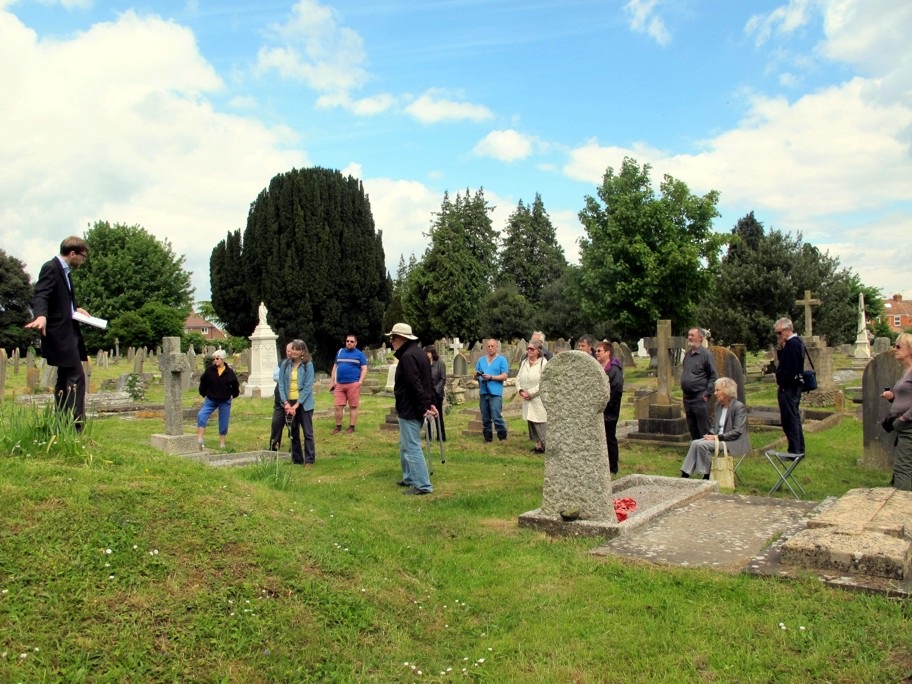
Next the group moved to the site of the former Anglican chapel. The Wembdon Road Cemetery was in fact two separate cemeteries, one Anglican and the other non-Anglican, or Dissenter. The Dissenters were the combined Unitarian, Presbyterian, Congregational, Wesleyan, Methodist and Quaker congregations. There's a zigzag that runs through the cemetery separating the two, consecrated and un-consecrated ground, and each had a separate chapel, management committee and we think, grounds man. This mound was the location of the Anglican chapel. This was a delightful octagonal building, designed by an architect called Brakespeare. A lodge stretched off to the side. It's a great shame this has gone as it was quite a unique little building and would certainly be something of a landmark today. The story goes, as we understand it, that it was more or less derelict by the 1970s so the vicar of St Mary's offered it to any builder who would like to demolish it and take away the materials. There's quite a few rockeries in the half mile round the cemetery with its creamy white Bath stone in their gardens.
One of the major problems with the Wembdon Road Cemetery today is that there is no great focus of attention. When you visit a pleasant country churchyard there's the church as a focal point, Here we don't have a focus anymore, something for all the memorials to metaphorically orbit: we visit and there's rows upon rows of memorial upon memorial, nice memorials too, but nothing to build up to. The cemetery really misses its focal points without the old chapels. And this is something we really need to remedy from a design point of view to give the whole place some coherence. What do we want to do about this then? Obviously we can't rebuild the chapel. But our honorary advisor came up with the idea of a sensory garden for the disabled. This would be a series of raised flower beds set within the footprint of the chapel, hopefully building up the walls to a modest height, maybe even rebuilding a gothic window. The idea would be that you could get a wheelchair in here and around.
We'd need to get the mound excavated, possibly a summer job for some archaeology enthusiasts. Then we'd need volunteers or contractors to build the flower beds and maybe a folly with the salvaged rubble. Combined with this some of these memorials would be put back up, and a hedge screen placed against the wooden fence there. The whole point is to get the look of the place right and appropriate. The Victorians understood this well. If you want a clock to work you need to make sure all the components are there and do their job: in the same way a cemetery is more than just the individual memorials, it's the whole setting.
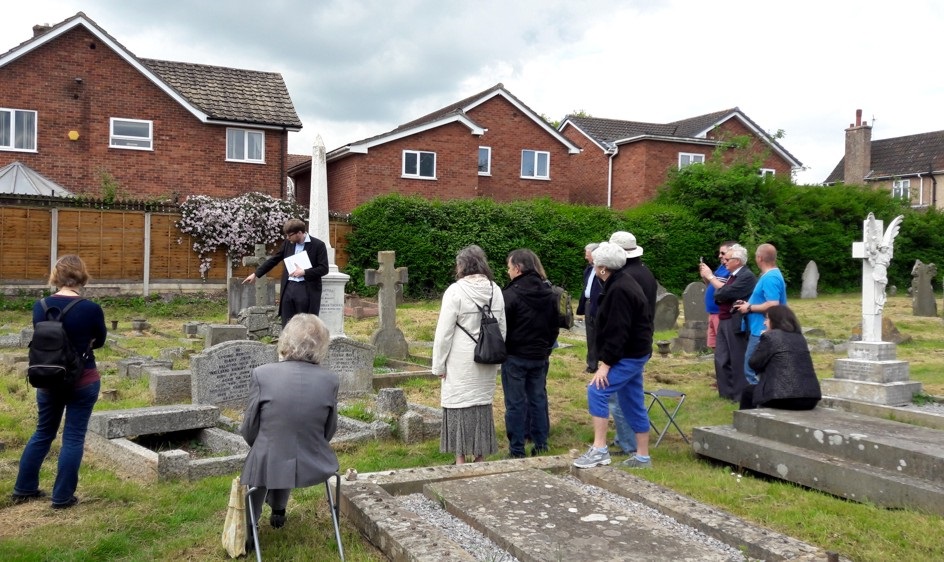
The group walked a little way further to look at a small collection of memorials. One was little more than a pile of rubble, and remembers members of the Philips family. It doesn't look like much today, only a mass of disarticulated pieces. Amazingly we have a photograph of how this once looked and a picture from the collections of the Blake Museum shows it with its decorative ironwork and large central vase. This is one we'd dearly love to put back together, but we'd need really specialist ironworkers to do so and these skills are more or less lost to us. It's a pipe dream, a low priority pipe dream, but one we can work on down the line.
Two large obelisks to the Richards and Tucker families were pointed out next. Obelisks are probably the easiest type of memorial to repair, as they usually have their stable bases still in situ and all it takes is Fine Memorials to come in and pin the pillar back into place, then we have great land marks which can be seen across the cemetery. We had these two put up to act as a sort of gateway as you're progressing from the main path towards the Paupers' Graveyard. Crosses are the next easiest thing to repair, working on the same principal, but a bit more tricky as they're top-heavy. Tombstones are costly, as foundations have to be set, pinning has to go on and any damage repaired.
Another memorial here, the Lott memorial was also mentioned. That stocky structure was sturdy when we started work, although somehow the urn on top had been removed. Fortunately when Fine Memorials were in one day they popped it back on for us. The vault underneath had, however, collapsed, so that whole side had sunk two or three feet, taking in the kerbs and the plinth. The volunteers spent week upon week upon week digging out the loose masonry and then repacking loose material to fill the gap, then resurfacing and cementing the kerbs back into place. Collapsed vaults and plots are a big problem, basically as coffins rot, they collapse and all the earth above gives in. Considering that some plots have up to seven burials in them this can result in a lot of movement and destabilises the memorials above. Fortunately for us most of the settling will have taken place by now, so when we have stones put back up they won't move any time soon. Now it looks like it has always been like that, but there's many, many man hours gone into it. There's a sort of iceberg of effort with this place, but it works that needs to be done - anyone can build or destroy, it takes a wise person to maintain.
Finally there is the Creedy angel, the most beautiful memorial in the cemetery. On the memorial is mentioned Raymond Creedy, it was this man's elderly younger brother who paid for this to be repaired. She was in a terrible state, he cross smashed, he wing broken. Fine Memorials pinned and glued her back together, while our volunteers spent ages taking of all the mud and grime to bring out the white shine of the marble.
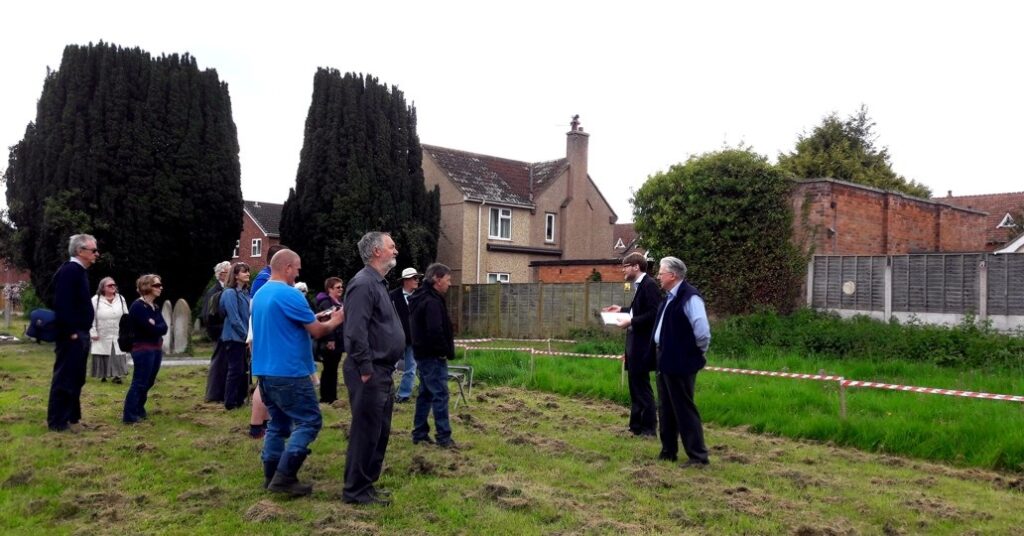
Next, the group walked over to the Paupers' burial ground. The stretch along the middle of this green was set aside for pauper burials, those too poor or unable to afford their own burial. There could be up to ten unrelated people buried in a single plot, it was left open but covered over for a couple of weeks until it was full. There are more burials concentrated here than in most of the rest of the cemetery. You can see there are no memorials - Paupers' weren't allowed memorials, so we had one put up, which was very kindly donated by the Cooperative Funeral Care. The aim of this memorial is so that those without a memorial can at last be remembered. It's incredibly hard to trace exactly where all the recorded burials are in this space, but relatives can at least come here and lay flowers somewhere.
There was a strip of memorials along the southern boundary though. For some unknown reason it was decided at some point to sweep them all away. Fortunately they were not taken away, so the year before last they were discovered while the volunteers were making preparations for a new border hedgerow along that fence (which, incidentally, is made up of native species recommended to us by the Somerset Wildlife Trust, the best ones to provide thorny protection for the neighbours with the best habitats for birds). The volunteers stumbled across a huge pile of broken stones, just dumped in a mass. They painstakingly dug these out, rearranged them using levers and rollers, like the Pyramids, and have lined them up.
Part of this area is roped off. This is because this is a trial section for a possible wild flower meadow, to help in a small way with the world's current bee crisis and to foster the natural habitat. Long grass provides a home for insects, which feed the birds and so forth. The eventual aim is to mark out the old burial sections and keep the old path ways in between. Last year we were donated some 4000 wild flower plugs by Sedgemoor District Council and these were planted for us by the Sedgemoor Conservation Volunteers.
There used to be a massive bramble patch creeping across half of this ground. That was cut back by the Friends so the area under the trees is again accessible, and a vast quantity of bluebell bulbs have been planted over under the canopy, to make a little blue bell wood. As we've cut back so much destructive bramble wilderness, we want to put back a much more manageable, diverse and pretty ecology.
The last thing to note here is the massive tree. That's a holm oak and its trunk is huge. We've taken measurements and that tree was planted in about 1800, so is by far the oldest thing in the cemetery. That was fifty years before the cemetery was laid out, fifteen years before the Battle of Waterloo. When that tree was planted Bridgwater stopped by the Broadway junction. That tree was on a field boundary from when all these fields were meadow lands. That tree outlived the entire history of the Jam Factory!
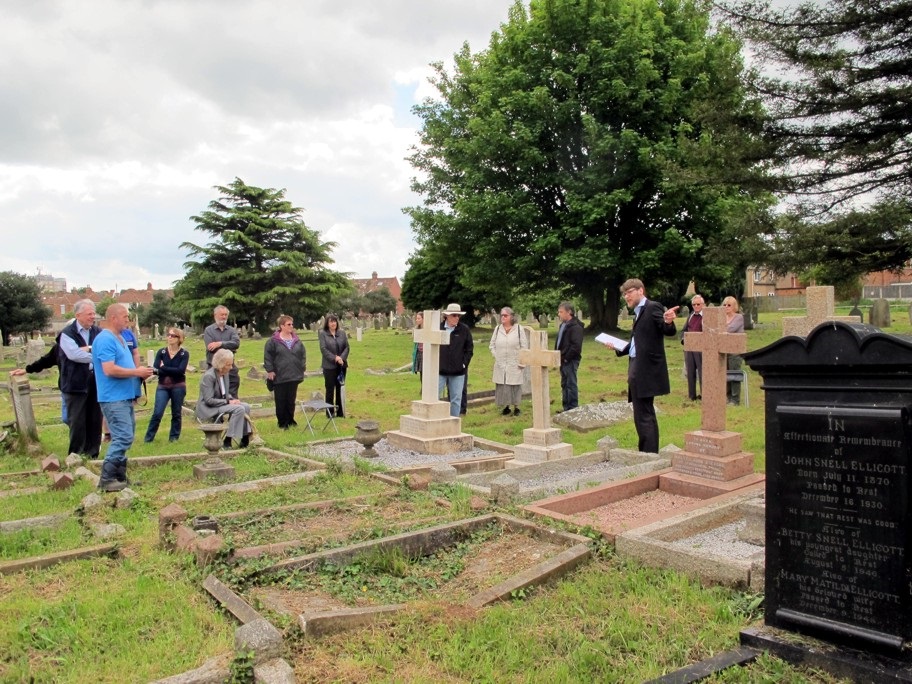
The group then moved to the cemetery's western boundary. This area was a complete mess until a couple of years ago. There was a massive bramble hedge and most of the memorials were toppled. The volunteers hacked back the brambles and we were very lucky for a very generous donation by a Mr and Mrs Fisher from London way, who paid not only for their own family tomb to be raised, but also to have the whole row done.
The descendants of the people in this cemetery are spread all over the world, and we are contacted by people in Canada, New Zealand, Australia, South Africa and the USA, all looking for their ancestors. Their membership of the Friends and their donations helps fund the repairs, bringing money and interest to Bridgwater from all over the world. Our website has most of the records relating to the cemetery, but they you have to be a member in order to access them. None of us have been hugely keen to make people pay for their history, but the membership fees this encourages does fund a lot of our efforts. So, unlike may other heritage organisations we have a healthy membership platform and a modest income stream. The main area we desperately need help with are volunteers and active committee officers to put all of this into action. We're a very modern group in that alot of organisation is done electronically, but we desperately need people on the ground with spades in hand.
One other thing in this area of note is the new green palisade fence. You may remember a rather tumble down chicken wire affair a few years ago. We didn't sort this out, but after we got going, Sedgemoor District Council, to support our efforts, put up a wholly new fence. Although they're against the wall in terms of funding and budgets and man power, since the Friends formed they have often bent over backwards, as far as they can, to help us.
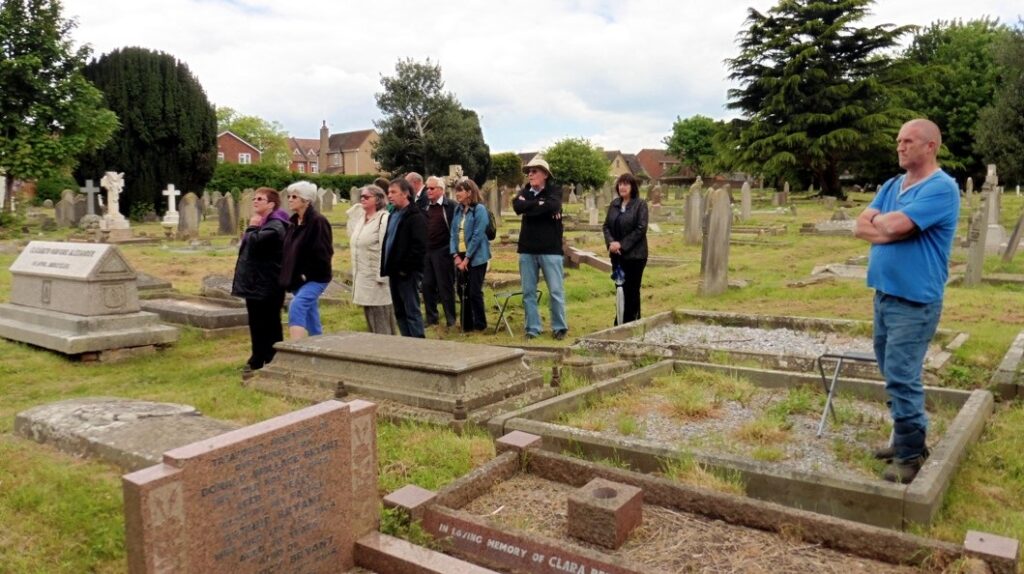
The group then marched the whole width of the cemetery, to where the old Dissenter chapel once stood. This was a more modest but a handsome little building. It lasted much longer than the Anglican chapel, finally be demolished in the 1990s.
The major difference with this one compared to the Anglican chapel is that there was a full vault below. This means there really isn't much we can do with it as any work on the mound, to build or even to level it flat, may lead to further collapse. Apparently the council lawnmower fell in it a few years ago.
We would like to better present the memorials that rest upon the mound, so one possible idea is that we hang them on the main boundary wall, and make that an architectural feature with little panels with the history of the cemetery and other plaques of remembrance.
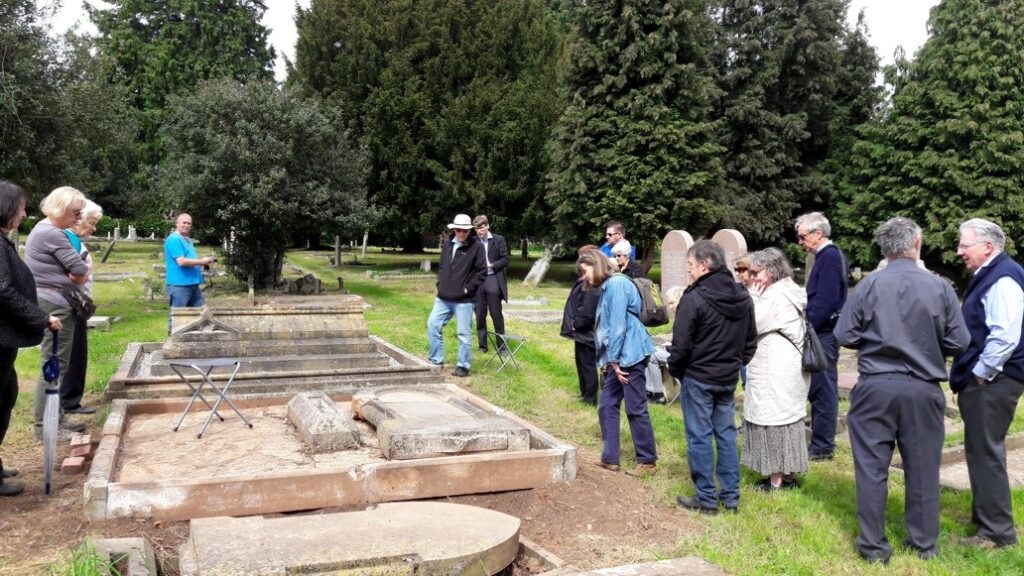
The group briefly stopped to admire the most recent work carried out by the Friends' volunteers, to repair two large memorials nearby.
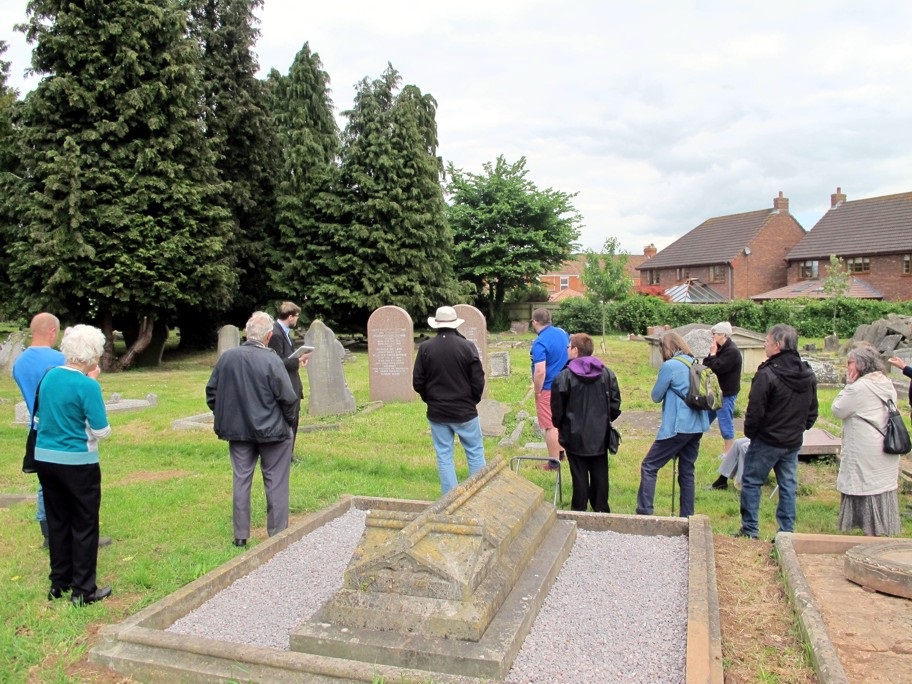
Across from these two are two large polished Peterhead granite stones. Another side to the Friends' activities is that of research. Research provides genealogical help for worldwide membership or content for the website. Both encourage membership, membership provides fees, fees provide funds for the conservation and restoration.
This memorial, among other, remembers one Isabella Metford, who was a Quaker and was related to the Clark family of inventors and shoe manufacturers. Last year the chairman purchased a copy of Jarman's History of Bridgwater from 1889, and inside that copy were all sorts of scribbles and notes - and they were by this lady. She was writing down her memories of the town from her youth. This makes her the first female historian of Bridgwater. Not only that, while looking into her life it turns out she was more than just a historian. She travelled all around the world, was an active theologian for the Quakers and, most exciting of all, was, with her sister, the first women in Bridgwater to champion women's suffrage. She even campaigned against worldwide slavery. She turns out to be one of the most remarkable people in this cemetery. But imagine if all the memorials in the cemetery were swept away, it would be far too easy for stories of people like this to be lost. We're hoping to get Isabella's memories and an account of her life published this year.
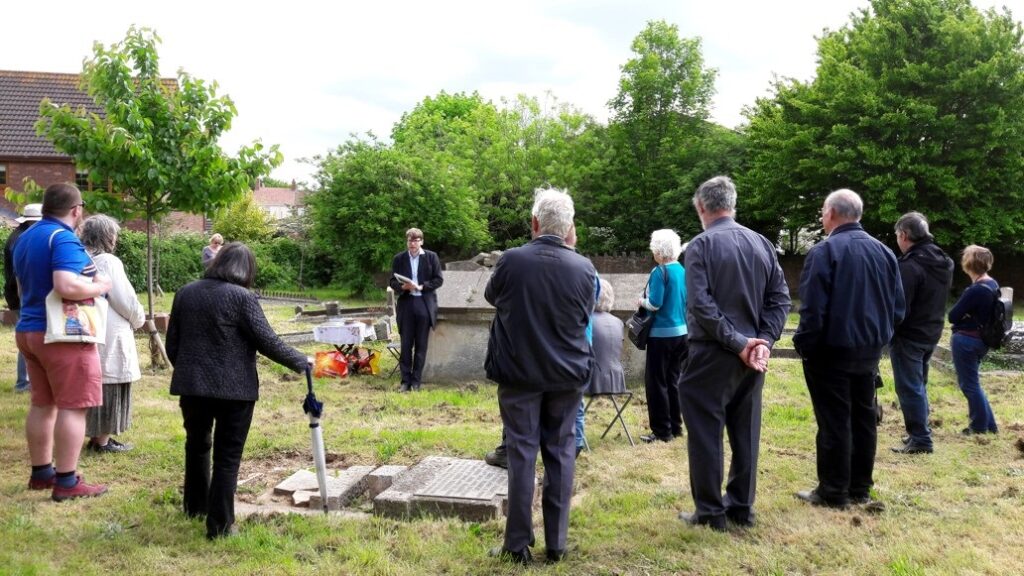
Finally the group went to the far corner of the cemetery. Brambles once engulfed this whole corner before being hacked back by the volunteers. To give you some idea, we had no idea the Holland memorial even existed when we started, it was deep within the overgrowth. When we found it, it had sunk to a forty-five degree angle. Fortunately, Ward Councillor Gill Slocombe paid to have it lifted and put right. If the name Holland sounds familiar it is because his name is on the side of the town bridge - being mayor when it was first opened in the 1880s.
Also uncovered is perhaps the most unusual memorial in the cemetery. We thought it was just another bramble clump, at least before we cut the greenery back. This memorial takes the form of a pre-historic cairn, albeit one with a solid brick vault below it. We have no idea why this form of memorial was chosen, and from my research it seems to be unique in Britain. This memorial remembers the Spiller family, who founded an incredibly important grain business and the forerunner of Winalot dog biscuits.
The other big memorial here is the Browne Vault, a classical mausoleum for a family of devout Unitarians and brick and tile manufacturers. That is actually a rebuild. If you look closely you'll see that part of the roof is concrete instead of stone and we've heard that it largely collapsed not too long ago and had to be put back together to stop children going in and helping themselves to bones. The key to its old door is apparently still with AB memorials in a draw in their office in town.
There are also new trees in this corner of the cemetery. Below the cherry tree is a modern memorial, one we had installed in the last month and that was rededicated the previous day. This remembers an old friend of ours, Dr Peter Cattermole, who suggested ten years ago that a record should be made of all the memorials here in case they were lost. That got the ball rolling and then to the formation of the Friends. So that brings us full circle to the close of the tour: past and present and we can look forward to the future.
You'll have seen that an awful lot of effort goes into every corner of this cemetery and we need help. We've never had much of a problem in terms of raising money for this place, but getting people in to get to work is. Our band of dedicated volunteers really need your help. Even a half hour to spare, it really makes all the difference. Attention and maintenance, but by bit, is what this place needs.
Having said that money isn't a problem, it is bally useful. If you have a family memorial here and would like it repaired do let us know. We also have a glossy guidebook you can purchase from our website.
Thank you for your time.
